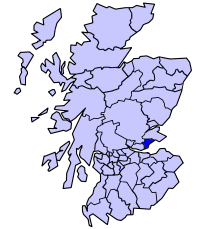Kirkcaldy (district) facts for kids
| Kirkcaldy | |
 Kirkcaldy Town House |
|
 Kirkcaldy district within Scotland |
|
| Geography | |
| HQ | Kirkcaldy |
| History | |
| Created | 16 May 1975 |
| Abolished | 31 March 1996 |
| Succeeded by | (Part of) Fife |
Quick facts for kids Demography |
|
|---|---|
| 1994 population | 148,450 |
| Politics | |
| Governance | Kirkcaldy District Council |
Kirkcaldy (which is Dùn Phàrlain in Scottish Gaelic and Dunfaurlin in Scots) was a special area in Scotland that had its own local government from 1975 to 1996. It was called a "district" and was part of the larger Fife "region."
The district was named after the town of Kirkcaldy. However, it covered a much bigger area than just the town. This included Glenrothes, which was the main town for the whole Fife region.
Contents
Understanding Kirkcaldy District's History
How Kirkcaldy District Was Formed
The Kirkcaldy district was one of three districts in the Fife region. The others were Dunfermline and North-East Fife. This district was mainly focused around the town of Kirkcaldy. Kirkcaldy was an important royal burgh, which is a type of historic town.
The district was created in 1975. This happened because of a law called the Local Government (Scotland) Act 1973. This law changed how local areas were managed across Scotland. It set up a two-part system: larger "regions" and smaller "districts" within them. Kirkcaldy became one of Fife's three districts.
Areas Included in Kirkcaldy District
When the Kirkcaldy district was formed, it took over from many older local areas. These older areas were all stopped at the same time. The new district included all of nine former areas and parts of two others from the historic county of Fife. These areas were:
- Buckhaven and Methil Burgh
- Burntisland Burgh
- Glenrothes District
- Kinghorn Burgh
- Kirkcaldy Burgh
- Kirkcaldy District (most of it)
- Leslie Burgh
- Leven Burgh
- Lochgelly District (only parts of it)
- Markinch Burgh
- Wemyss District
Life in the Kirkcaldy District
Beyond the main town of Kirkcaldy, the district included several different types of communities. It had the coastal towns of Levenmouth and villages like Burntisland. There were also mining towns such as Cardenden. The district also included the growing new town of Glenrothes. Glenrothes was chosen as the main town for the Fife region.
This sometimes caused disagreements between the Kirkcaldy District Council and Glenrothes. Glenrothes had its own development group, but it still needed to work with Kirkcaldy for local matters.
Kirkcaldy district was quite large. It had the sixth-biggest population out of the 53 districts in Scotland at that time. It shared borders with the North Sea to the east and with the Dunfermline and North-East Fife districts. It also had a small border with Perth and Kinross district to the west.
Changes in 1996
In 1996, the way Scotland was governed changed again. The districts and regions were all stopped by a new law. Fife then became a single "unitary council area." This means it had only one level of local government. The main office for this new Fife council was in Glenrothes.
Even though the district no longer exists, its old boundaries are sometimes still used. They are used for things like planning the local economy or policing. These areas might be called 'Mid Fife' or 'Central Fife'. Sometimes, Kirkcaldy and Glenrothes are managed separately because they are so big. Other towns like Cowdenbeath might be added to these areas to make them larger, for example, for Scottish Parliament elections.
Who Was in Charge? Political Control
The first election for the Kirkcaldy District Council happened in 1974. The council officially started its work on May 16, 1975. Here's which political party was in charge of the council during its time:
| Party in control | Years | |
|---|---|---|
| Labour | 1975–1977 | |
| No overall control | 1977–1980 | |
| Labour | 1980–1996 | |
Where the Council Met: Premises
The Kirkcaldy District Council had its main office at Kirkcaldy Town House. This building is located at 2 Wemyssfield in Kirkcaldy. It was built in 1956 for the old Kirkcaldy Town Council.
See also
- 1992 Kirkcaldy District Council election
- Subdivisions of Scotland

